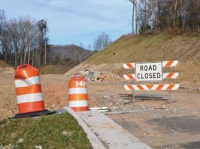A year later, there is still much to be done

Earlier this week, I had started writing a column about the progress made in the year since the flooding from Tropical Storm devastated parts of Haywood County. Then, as I started talking to our writers about the stories they were preparing for this week’s edition — one year after the flood — I could tell they had the recovery efforts well covered.
So I trashed that column and decided to re-publish the experience I had when I went to cover the aftermath of the raging floodwaters that swept through Cruso, Bethel and Canton. I remember that morning vividly, how almost every one of the people who talked about their experience started out their conversations by shaking their heads, as if still in disbelief about what they had been through. Hell, as I wrote a year ago, I felt shell shocked just venturing into the aftermath on the morning after.
There is still much work to be done, and our thoughts are with all whose lives were disrupted by this tragic natural disaster.
The time stamp on the photo from my iPhone reads 7:29 a.m. It was Wednesday, Aug. 18, a mountain morning full of sunshine and a cool freshness that’s common after rain the day before. Turning onto Wells Road, which connects N.C. 215 and N.C. 110 in Bethel via a bridge across the Pigeon River, I got my first glimpse of the destruction that the river and the rain had wrought the previous night.
Our reporter Cory Vaillancourt had started texting our news staff late Tuesday evening, warning us that things were very bad in Cruso, Bethel, Clyde and Canton. We needed to hit the ground early Wednesday and start reporting on what’s now called the Great Flood of 2021.
I wasn’t prepared for what I found. It was otherworldly. At 7:30 a.m. the river was still raging, the crops beaten down and the sun rising as mist hovered over the fields. Mud was all over the road and bridge on Wells Road, which is a good 20 feet above the Pigeon.
Related Items
Heading upriver on N.C. 110 the scenes just got worse. The workers at a rock yard right on the river were already onsite and cleaning up. The guys who run Accurate Auto Repair just across the street were also already trying to assess the damage. One, wearing a shirt from that business, said, like so many others, that “it just all happened so fast, it was a foot deep and then it was waist deep and rising.” I saw cornstalks on power lines 15 feet in the air across Max Thompson Road, mud several feet deep in low areas.
One story kept repeating itself with frightening regularity: efforts to save cars and possessions were abandoned as the water came so fast and deep and powerful that it unleashed a primal instinct to just survive and save the lives of loved ones. Tragically, some didn’t make it, swept away in a maelstrom the likes of which few have ever witnessed.
Already shellshocked after spending 30 minutes in Bethel, I drove up U.S. 276 and the wreckage only got worse. The valley forged by the East Fork of the Pigeon had homes, cars, outbuildings, boats, tools, furniture, toys and everything else out of place, all order seemingly gone. Huge boulders had been tossed around like they weighed nothing. Slabs of pavement from roads and driveways were stacked against splintered trees.
I heard tragic stories: a man swept from a truckbed by the water and acquaintances not knowing that morning if he had survived; campground refugees who feared for the lives of those they said were washed away while taking refuge in some sort of pavilion.
I was headed out of Cruso by 9:30 a.m. Already, scores of people were at work, the parking lots of the Cruso VFD and the East Fork Baptist Church were packed, DOT workers were already repairing roads, volunteers showing up to do whatever they could. I drove out as roadblocks were being set up to monitor who went into the areas where the devastation was the worst.
By now, the story of this flood is well known. More than two feet of rain came down in Cruso, even more in parts of Jackson and Transylvania counties. The Pigeon crested at 20 feet; its depth the days before the storm was two feet. As the river surged that afternoon and evening, the heavens oscillated between periods of torrential rain to sunshine and clear skies.
Now the aftermath. Five souls lost, hundreds of lives upended, local governments, schools, churches and businesses trying to do what they can to help with this tragedy in the midst of a raging pandemic that just won’t go away.
It’s hard to see now, but there is light at the end of this. There just has to be.
(Scott McLeod can be reached at This email address is being protected from spambots. You need JavaScript enabled to view it..)









